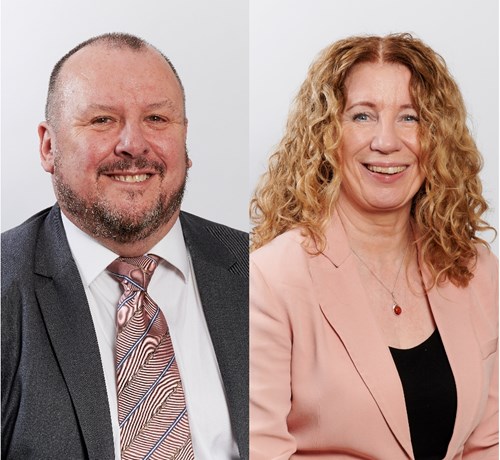Mark Smith ACMA CPFA, Director of Finance at NHS Arden & GEM CSU, and Rose Taylor RGN RHV, Director of Healthcare Solutions at NHS Arden & GEM CSU, share highlights from a recent roundtable with NHS finance leaders.

Using resources efficiently and sustainably is one third of the Triple Aim which all NHS bodies have a legal duty to deliver. With it comes myriad challenges, not least in navigating the significant cultural shift that is required to make system working deliver in practice. A drive for efficiency is not new in the NHS, but how it might be achieved in this new collaborative way of working, combined with the lasting effects of the pandemic on resources, is taking us into unchartered territory. NHS Arden & GEM CSU hosted a roundtable with finance experts from across the health system to help develop a common understanding of the challenges and seek consensus around potential solutions.
Current resource allocation
Before looking at what we can do better, the group considered how sustainably and efficiently resources are used now. The national resource allocation formula transparently allocates funding to regions based on sound principles of population demographics and health needs, as well as excess cost factors such as care delivery in remote areas. However, these principles are often overtaken by the reality of supply in local areas, which becomes the dominant driver for which there is no easy fix.
As a group, we felt this situation is exacerbated by three factors. Firstly, there is no common means of determining value across different parts of the system (across different health conditions or across different providers). Secondly, the closed bookkeeping legacy of the quasi-market that has been operating across the NHS for some years makes it difficult to get a clear picture of spend and costs across the system. Finally, resource discussions can be skewed simply by the data available. Generally speaking, resource information is more readily and comprehensively available in the acute sector in comparison to mental health, community and primary care providers. That imbalance makes it more difficult to make robust decisions as the resource picture is incomplete.
Barriers to change
It is important to recognise that there are many good examples of programmes of work that have improved efficiency. However, when it comes to reallocating resources, this is often only done in the margins and when funds allow. There is a tendency to make small shifts rather than taking a step back and looking at the use of resources as a whole. Consequently, a significant proportion of funding is allocated to services which may deliver less value for the population and for the wider system.
We must also acknowledge the part individuals and organisational culture play in achieving the Triple Aim, and particularly the demand for efficient and sustainable use of resources. Our own definitions of success and self-worth can drive behaviours that are more closely aligned to organisational success than system-wide progress or long-term sustainability. Moving from activity-based payment towards outcomes-based commissioning has removed one of the perverse financial incentives where volume or activity trumped efficacy of outcome. But instead of simply switching to a block contract approach, we need to work together to redefine what it means to be successful when collaborating to deliver the Triple Aim as part of a system.
There is a tendency to focus primarily on money when considering resource allocation. But we are starting to see a shift towards a limited workforce being the main finite resource, particularly clinical staff. As finance leaders working with or within ICBs, we need to be taking a much broader view of what we mean by efficient and sustainable resources to meet changing needs encompassed by this element of the Triple Aim.
Practical steps towards financial sustainability
As a group, we identified five steps which would make a positive contribution towards enabling ICBs to achieve financial sustainability through more open, transparent and collaborative ways of working.
1. Introduce open book accounting and a common measure of value. This is naturally easier said than done and requires organisational development support to build the confidence to enable a more open approach. However, we need to be in a position to answer the following questions: What are the actual costs of delivering a service and what value does it provide? Is it increasing health and wellbeing more than an alternative service or would it use finite resources inefficiently?
2. Use different language and redefine success. A first step towards changing the culture would be for leaders to describe and congratulate people on their success in using resources efficiently and sustainably to increase health and wellbeing. As Integrated Care Systems find their feet, ICBs have an opportunity to redefine success based on the degree to which they have contributed to the common purpose rather than growth in their own service area.
3. Encourage learning and testing. We are in new territory here. ICBs have statutory functions and funding which formalise partnership working across health and social care in ways we are not used to. To take full advantage of this opportunity, systems need to have environments for constant testing and continuous value improvement. It is okay to test and ‘fail’ – the error comes in either not testing or in persisting with a low value service.
4. Recognise that the NHS is in the health and wellbeing business. While health and wellbeing is impacted greatly by other services such as housing, education and employment, the NHS is a major contributor. Alongside working with our system partners, NHS organisations should continuously review whether resources are being used sustainably and efficiently to increase health and wellbeing and enable access to services for those that need it the most.
5. Secure clinical buy-in for change. Involving clinicians is key to increasing sustainability alongside improving population outcomes. Clinical involvement helps us to better understand the barriers to change and find ways to overcome these as part of a genuine approach to co-designing services and pathways.
Tackling the challenges we face today, and taking advantage of the opportunities that lie ahead, requires visible and committed leadership to create the conditions in which that can happen. This isn’t about ‘quick fixes’ but a concerted effort to use this new system structure to re-evaluate how we use precious, finite resources to meet the growing needs of our population. It’s an opportunity we can’t afford to miss.
This blog is taken from an article published in the November/December 2022 issue of National Health Executive. You can read the full article here.
Participants included:
- Alison Tonge, Director of Integrated Service Development at NHS Arden & GEM CSU
- Andy Gant, Senior Finance Lead at NHS Arden & GEM CSU
- Ashley King, Director of Finance Primary Care & Strategic Programmes at NHS Mid and South Essex ICB
- Clare Hollingworth, Director of Finance & Resources at Coventry and Warwickshire Partnership NHS Trust
- Ed Cox, Director of Clinical Policy at NHS Mid and South Essex ICS
- Elizabeth Nalwadda, Clinical Prioritisation Manager at NHS Birmingham and Solihull ICB
- Gary Graham, Director of ICS Development at NHS Arden & GEM CSU
- Jason Bloomfield, Chief Operating Officer at NHS Arden & GEM CSU
- Karen Parkin, Operational Director of Finance at NHS West Yorkshire ICB
- Kay Stevenson, Consultant Physiotherapist, Regional AHP MSK Lead, Senior Knowledge Mobilisation Fellow and Honorary Professor Musculoskeletal Care and Leadership at Midlands Partnership NHS Foundation Trust
- Mark Costello, Deputy Director of Finance at Saint Mary's Hospital, Manchester University NHS Foundation Trust
- Michael Cawley, Operational Director of Finance at NHS Nottingham and Nottinghamshire ICB
- Mitalee Pisavadia, Clinical Prioritisation Officer at NHS Birmingham and Solihull ICB
- Nick Relph, Qualified Accountant and Former NHS Chief Executive and ICS Chair.
